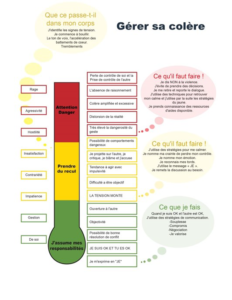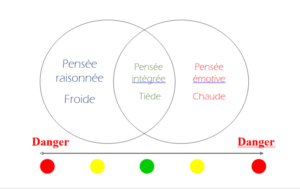Managing expectations and emotions
Expectations generate emotions. When an expectation is met, we experience satisfaction and joy. When it is not met, we experience frustration, disappointment, anger, etc.
It is, therefore, essential to understand what our expectations are so that we can meet them on our own.
Here is an overview of the steps for meeting your expectations
Step 1 : Differentiate between expectations, needs and desires
Expectation : The act of looking forward to someone or something. To count on someone.
Need : A feeling of deprivation that leads one to desire what one believes one lacks. A vital necessity.
Desire : The act of desiring, aspiring to have, to obtain, or to do something. A want, wish.
Step 2 : Obstacles to self-sufficiency
- What prevents me from meeting my own needs?
- Do I want someone to take care of me?
- If someone else succeeds in meeting my needs or expectations, do I consider this proof of their love or does it make me feel important?
Step 3 : Realistic expectations
- Is my expectation realistic?
- I may expect others to act as I would in a similar situation.
- https://www.merriam-webster.com/dictionary/need
Stress management
We know that those who assist a loved one in their recovery are usually under a lot of stress. Depending on their social standing (parent, child, sibling, spouse, friend, etc.), age, or relationship with their loved one, individuals will experience different emotions that can affect their personal well-being.
It is important to note that living with serious concerns leads to a level of anxiety that can become as serious as the problem that caused it. Stress is a physical and emotional reaction experienced by all humans. When it is moderate, it can motivate and stimulate us. On the other hand, when it is excessive, it can have negative impacts on our health, family or social relationships, work, mood and perceptions.
Stress becomes a problem when our reactions become inadequate and when we experience a profound state of discomfort or unease and feel exhausted.
Some people may even develop physical symptoms related to stress, such as neck tension, stomach knots, shortness of breath, headache, nausea, nervous agitation, decreased ability to concentrate, impaired memory, irritability, nervousness, impatience, procrastination, sudden movements, increased reactivity to the actions of others, etc.
You should be mindful of these impacts because they can be harmful in several ways.
One of the first things to do is ask yourself: What am I afraid of? What in my current situation is bothering or upsetting me? Can I look at things in a different way? What do I need to feel better? Am I confident in my ability to handle it all? How have I handled anxiety-provoking situations in the past?
Identifying sources of stress and their symptoms allows you to act quickly.
Emotional-rational continuum to determine your stress level
The three types of thoughts
Assess your condition

Where does anger come from and how can I manage it?
These emotions are very common among people who live with a loved one with a mental health problem. This is especially true because of age, interpersonal relationships, and a lack of understanding of what is causing all the chaos around them. As Joany explains, she now has a better understanding of the situation and has learned to listen.
Anger and relationships
From the time we are infants, we are introduced to emotions and ways to manage them. A wide variety of emotions exist, including fear, boredom, pleasure, sadness and anger. This last emotion, although present in all human beings, is experienced very differently from one person to another. This normal emotion can be seen as problematic when in fact it has been a tool for human survival since the dawn of time. The true role of anger is to provide the energy required to overcome obstacles we encounter. Thus, the problem is not the anger itself, but rather the decoding of it and the person’s immediate reaction to it. In this article, we will discuss problematic ways individuals deal with their anger, such as repression, disproportionate outbursts or passive-aggressive behaviours. We will present an introduction to the emotional process as well as different ways of living with this emotion.
The origin of anger
Anger is a defensive reaction to a perceived threat, a loss or stress. This reaction can be caused by an internal or external trigger.
- For example, an external trigger may be a difficult to accept breakup or a lie told by a close friend.
- An internal trigger may be a person who is very sarcastic and quick to find the shortcomings of others, which allows them to avoid confronting their own weaknesses.
What we identify as the source of our frustration, whether external or internal, does not change the responsibility individuals have in managing their reaction. It is up to each individual to learn to manage their anger in a healthy way.
The purpose of our emotions is to inform us about the degree to which our needs are being met and the state of our personal well-being. Therefore, the presence of anger indicates that an individual’s internal balance has been upset by unsatisfied needs, desires, or expectations. It is therefore essential to recognize the origin of the anger in order to find better ways to deal with it and to have healthier and more fulfilling interpersonal relationships.
Repressed anger
Throughout childhood, we often learn general ways to better manage our emotions. Some people will learn to suppress their anger at an early age and will end up using this technique as a systematic defence mechanism to avoid feeling the emotion. To avoid any form of confrontation with themselves or others, they will not allow themselves to experience their anger. Their fear of confrontation is strong enough to avoid contact with any form of anger and to use a number of strategies to avoid giving credit to their emotion. Unfortunately, these defence mechanisms can have adverse consequences. For example, it could lead to a lack of respect for them in various interpersonal relationships.
Note: the repression of anger can, in the medium to long term, have destructive and unpredictable repercussions, for oneself and/or others.
Explosive anger
Some people will express their anger in ways that are disproportionate to the event. These individuals will send numerous verbal and non-verbal signals, such as becoming red in the face, breaking things, giving insults, or hitting, in an attempt to express their displeasure in an excessive manner. These behaviours will systematically deteriorate, or even destroy, their interpersonal relationships.
Daily annoyances will rekindle their frustrations and anger, leading to confusing situations for those around them, who never know in what emotional state their loved one will be. Without working on oneself, the goal of achieving harmonious relationships and the inner peace that comes with balance will remain out of reach.
______________
The Nail Story
Once upon a time there was a little boy with a bad temper. His father gave him a bag of nails and told him to hammer a nail into the fence every time he got angry.
On the first day, the child hammered 37 nails into the fence. Over the next few weeks, he hammered fewer nails as he learned to control himself. Finally, the day came when the child no longer had explosive anger. His father suggested removing a nail for each day he was able to control himself. When all the nails had been removed, the father spoke to his son: “That’s great, but look at all the holes in the fence. It will never be the same again. When you say things in anger, they leave marks just like these nails. Even if you apologize afterwards, the wounds will still be there.”
The little boy, touched by these words, looked up at his father and said: “I hope you can forgive me for all the holes I’ve made in you. ”
“Of course I can,” said the father.
_____________
Passive-aggressive behaviour
Passive-aggressive individuals do not express their anger openly. They pass it off to others around them so that they get angry instead. These individuals may be quick to blame others and may exaggerate their problems or complain often. They often avoid direct confrontation or expressing their anger and put up various relational barriers, whether consciously or not. Some individuals will “sulk” and often procrastinate.
Instead of directly refusing a proposed task, people who engage in passive-aggressive behaviours will avoid performing the task in hopes of getting out of it altogether. In addition, they often send ambivalent messages. For example, they may say an unfriendly comment in a kind and affectionate tone, leaving those around them perplexed. These individuals may then claim that their loved one is being overly sensitive in his or her reaction to their ambivalent comments. Often critical of others, these individuals may remain silent rather than engaging in discussion.
What to do with your anger?
First of all, it is important to stop blaming yourself and get out of the victim role. We are responsible for our own emotions, and it is possible to improve the way we manage them.
Step 1
- Conduct a self-observation when you feel hurt in order to identify your reactive patterns.
- Accept your anger without putting on a mask to hide it. This will allow you to better deal with your anger.
- Identify internal and external factors that trigger your anger more easily.
This identification step will allow you to be more self-aware in these types of situations. Self-reflection also helps to identify the source of anger issues. This type of reflection should allow you to identify what is causing your anger and what makes you react the way you do.
Step 2
- Describe your anger and reflect upon how you respond to that feeling.
- Describe the body sensations associated with anger.
- Assess the benefits of remaining in this state as well as the need to hold on to this anger.
When practising self-reflection, it is a good idea to try the exercise with small annoyances until you become more familiar with this skill.
The 5-stage emotional process
Stage 1
The first stage in this five-stage emotional process is emergence, the moment when anger appears. This emotion may be felt in many ways, including fear. This first stage ends when the person is able to clearly name their emotion.
Stage 2
The second stage is immersion. At this stage, the person must feel the emotion that has appeared and surrender to it as it appears in order to experience its full intensity. When the person is willing to fully experience their emotion, the transition to the third stage begins.
Stage 3
Development, which corresponds to the third stage of the emotional process, is the stage in which the experience can be dissected and explored so as to reveal its different facets. At this level, the person must actively explore the factors that make up their emotional state. The more complex the experience, the more necessary it is to identify all the factors that led to this emotion.
Stage 4
The meaning-making stage allows us to grasp the meaning behind our experience. This stage is about understanding why we feel this emotion so we can take it into account and determine how we should behave. After completing this fourth step, the individual will automatically move on to the last stage, which is the unifying action.
Stage 5
The unifying action stage is accomplished through action, verbal expression or both in order to accurately express the experience to the person involved in the event that triggered the anger. Obviously, when expressing yourself verbally, it is important to be able to speak to your loved one in a calm manner, avoiding attacks or reproaches. Make sure the other person has understood by confirming what was said.
During non-violent verbal communication, listening to what your loved one has to say is also suggested so that they can express themselves. Listening carefully is important, and it is equally important for you to confirm your own understanding.
Sometimes, during this type of interaction, it may be possible to come to an agreement in order to find solutions and satisfy your unmet needs or desires. It is your unsatisfied needs, desires or expectations that contribute to your anger. The common ground established with the other person should be discussed again later. It is important to keep in mind that connecting with one’s own ability to regain self-control and manage one’s problems is not possible when one is submerged in anger or any other emotion.
Thus, taking care of ourselves in the moment often means doing nothing in order to consciously distance ourselves from our anger. This may mean stopping for a while to take a deep breath and then engaging in an activity, for at least 30 minutes, in order to release the anger and gain a better understanding of it later on.
It is important to allow yourself to go through the emotional process to confront past behaviours that are contributing to your current level of anger. In addition, communication methods will need to be established at the end of the process in order to complete the unifying action stage.
In conclusion, anger is an emotion that may seem simple, but each person experiences it differently according to their own experiences and trauma. Learning to live with your anger is an essential step in your personal development in order to avoid destroying yourself or your interpersonal relationships. When using the emotional process as well as other available management tools, it is important to reflect upon the defence mechanisms you have created to deal with your emotions, so that they can be changed.

Gabrielle Brind’Amour, Executive Director at L’Accolade Santé mentale.






